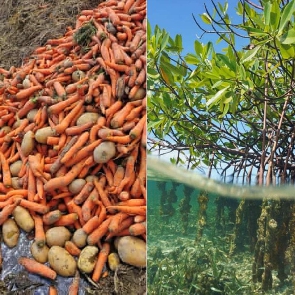Continuously, there are urgent global calls for climate actions to be taken. The greater concern has been the fear that more people will fall into poverty from the shocks of climate, and these are justifiably so because of the unattended effects of the change in the climates around the world.
Updates coming in from the Ghana Meteorological Agency (GMA) on what people should expect from the weather may not always be timely, but at least, thanks to smart mobile phones today, people are able to get a fair idea of what to expect as they step out each day.
And when it has seemed like the biggest concerns of the changes in weather patterns have included, for instance, rainfalls in the originally dry seasons, or the unexplainable heat that gives many people reasons to be worried, these alone are not the biggest concerns on the subject matter.
Rather, there have been some unspoken areas of the global chain that contribute to climate change in a more subtle way that it is given attention. This article will focus on two of those major areas that continue to impact climate change across the world.

Damsea photo
Mangroves
By definition, mangroves are tropical plants that are adapted to loose, wet soils, salt water, and being periodically submerged by tides. According to an article on floridadep.gov, there are four major factors that appear to limit the distribution of mangroves: climate, salt water, tidal fluctuation, and soil type.
With more than 60 different species of mangrove trees, all specialized to grow along waterlogged coastlines in tropical and subtropical regions, they form part of some of the most important solutions to the climate situation in the world.
Also, a report put together by Muntaka Chasant, who refers to himself as an entrepreneur and documentary photographer, showed that in Ghana, mangroves are mostly found in nearshore lagoons and estuarine environments – mainly around the Volta Delta and along the western coastline between Cote d’Ivoire and Cape Three Points.
Despite being relatively unknown, they are an incredible group of plants, worldwildlife.org says. They not also only have a unique ability to thrive in saltwater environments, but their strong and complex root systems protect coastal communities and landscapes from extreme weather events, like hurricanes.
But mangroves are not just what they are for nothing. Due to their unique features, they are also referred to as a “nature-based solution” to the climate situation around the world.
Also, while mangrove forests stabilize shorelines, contribute to the reduction in erosion, and provide essential habitats for many animals, including species that are considered threatened or endangered, more than 40% of the world’s area of mangroves is in only 4 countries.
These countries are Indonesia (19%), Brazil (9%), Nigeria (7%), and Mexico (6%).
World Wildlife explains further that one of the biggest strengths of mangroves in dealing with climate issues, is their ability to capture and store carbon. So, mangroves are natural carbon sinks and are able to store carbon more than natural forests.
“The muddy soil that mangroves live in is extremely carbon-rich and over time the mangroves help to not only add to this store of soil by capturing sediment but hold it—and the carbon—in place. The amount of carbon stored beneath these trees is estimated to be up to four times greater than that stored by other tropical forests, making these coastal forests extremely valuable in the fight against climate change.”

What the expert say about this
In an interview with the Founder of the Ghana Youth Environmental Movement (GYEM), Gideon Commey, he explained that Ghana’s share of the mangroves distribution around the world is threatened.
“There is enough evidence that mangroves in Ghana are under serious threat of exploitation through a wide range of human activities. Considering the roles they play in climate mitigation and adaptation as nature-based solution agents, we need urgent action to address their destruction through the sensitization of coastal communities and fisherfolks. Advocacy efforts on mangroves should also be amplified to draw the attention of policy makers to implement and enforce the appropriate legislation and regulations to safeguard mangroves,” he explained.
The UNEP 2007 report showed that the total mangrove area in Ghana is around 137 kilometres squared.

Alistair Scot photo
Food
If food waste were a country, it would be the third-largest emitting country in the world.
On the subject of food, generally, food systems play a very significant role in climate change.
From farm to fork, all the processes in between - production, harvesting, transportation, processing, packaging, and disposal (food waste, etc), all contribute greatly to climate change impacts.
The UN reports that plant-based foods such as fruits and vegetables, whole grains, beans, peas, nuts, and lentils – generally, use less energy, land, and water, and have lower greenhouse gas intensities than animal-based foods.
There is, therefore, the need to reduce emissions from the food sector, and this requires changes at all stages, from producers to consumers.
Again, the UN suggests that where appropriate, there should be a shift in food systems that lead to plant-rich diets, with more plant protein (such as beans, chickpeas, lentils, nuts, and grains), a reduced number of animal-based foods (meat and dairy) and less saturated fats (butter, milk, cheese, meat, coconut oil and palm oil) – that can lead to a significant reduction in greenhouse gas emissions, as compared to current dietary patterns in most industrialized countries.
Alternative proteins – such as plant-based meat and dairy substitutes, insect-based proteins, and cell-based/cultivated meat – provide promising prospects and are attracting growing demand, financial investment and technological innovation.
And then, there is the need to reduce food waste. This is a key feature to tackling climate-related issues.
Gideon Commey of GYEM again explains the effects of food on the climatic dynamics of the world.
He explained how only recently discussions about the impacts of good on the climate have been included.
“More than 30% of global greenhouse gas (GHG) emissions come from food production, food waste accounts for about 8%. It is surprising that the conversation on food systems and climate change only started gaining traction at the UN level. To put things into perspective; COP27 was the first time we had a Food Systems Pavillion at the COP.
“The impact of our food system on biodiversity is even dire; the global food system is the largest driver of biodiversity loss, with agriculture alone the leading threat to 86% of the world's species at risk of extinction.
“We have a lot of work to do in Ghana to address food-related climate impacts while solving food inequality and food poverty. Activists and campaigners have to raise the profile of this issue, journalists have to write about it and politicians need to listen because we are running out of time. Hunger and rising food costs will only keep growing if our food system continues to drive climate change and nature decline as is currently happening,” he stressed.
Other available statistics show that out of 1 billion tons of food in the world, a staggering 17 percent of it ends up in the trash bins, every year. “Producing, transporting, and letting that food rot contribute more than 8 percent of global greenhouse gas emissions. If food waste were a country, it would be the third-largest emitting country in the world.”
Just as the COP27 has started giving attention to such discussions on food and its impacts on climate, more is expected from global leaders and activists in pushing the conversations on some of the least spoken about areas that adversely affect climate around the world.
This report is produced in fulfilment of the UNESCO & CIJ London Climate Change in News Media project facilitated by the Centre for Journalism Innovation and Development.
By Etsey Atisu
General News of Friday, 26 May 2023
Source: www.ghanaweb.com



![Kurt Okraku[L] Andre Ayew and Stephen Appiah Kurt Okraku[L] Andre Ayew and Stephen Appiah](https://cdn.ghanaweb.com/imagelib/pics/279/27934294.295.jpg)









